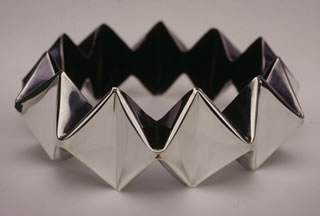The Body Beautiful
 |
|
|
 |
|
|
 |
|
|
There are people who hate being stared at. Arline Fisch is not one of them. An imposing, self-assured woman who has been making jewelry for more than 60 years, Fisch is also her own best customer.
In the rather conservative city of Copenhagen back in the 1950s, Fisch was out for an evening at the Royal Theater, draped in two full-length pieces in silver, her escort in formal attire.
“We would promenade,” she says, “just to see what people would say. They were sort of stunned but no one laughed, and no one shot me.”
As art objects go, pieces of jewelry are among the smallest. The casual museumgoer may pass by the jewelry case with scarce a look—if the museum has any jewelry at all. All too often it does not because jewelry is considered more craft than art by many fine arts curators.
“They think craftspeople are just cornball,” says Merry Renk, whose jewelry-making career is as extensive as Fisch’s. “Of course they aren’t.”
Today, close to 70 years after ‘studio jewelry,’ or ‘artist jewelry’ emerged as a recognized discipline, jewelry as art is finding newfound attention—including among fans of mid-century modern design, most of whom have in the past lavished their affections on architecture, furnishings, and graphic design more than on necklaces and brooches.
 |
|
|
The Los Angeles County Museum of Art (LACMA) is now celebrating California mid-century modern jewelry as part of its exhibition ‘California Design, 1930–1965: Living in a Modern Way.’
The exhibit is notable for its focus on lesser known designers as well as more iconic figures, says Bobbye Tigerman, an assistant curator at the museum who co-curated the show with Wendy Kaplan, chief curator for decorative arts. The exhibit is also focusing on lesser-known art forms, like jewelry and fashion, along with furniture, ceramics, textiles, and architecture.
Although jewelry does not make up a significant part of the LACMA exhibition by bulk—the show includes only about 18 pieces, including one by Fisch, two by Renk, and work by Margaret De Patta, Peter Macchiarini, Florence Resnikoff, and Harry Bertoia, among others—there will be enough to suggest the riches of modern California jewelry.
The exhibit and its accompanying publications will also shine a light on the history of modern California jewelry—which, not surprisingly, strikingly resembles the history of modern California architecture.
Both blossomed after World War II, their techniques and ideas building on the work of prewar pioneers; both benefited from postwar optimism and energy; and both employed new forms, materials, and techniques that went well beyond the traditional.
 |
|
|
“After World War II,” says, Joanna Rhoades, whose gallery, Taboo Studio Contemporary Art Jewelry in San Diego, sells work by Fisch, “there was a shift from [jewelry] being just a decorative item to something unique and individual to the artist, their own personal style.”




